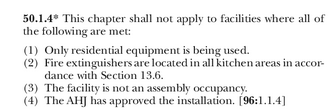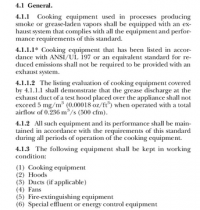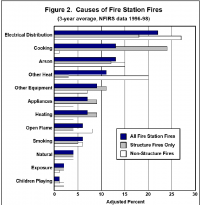Tim Mailloux
REGISTERED
I am working on a new fire station with barracks in MA, the state code is based on the 2015 IBC with state amendments. The building is going to be type 2B construction, fully sprinklered, non separated mixed use B, R-2, A-3 & S-2.
Seeing how the station will have sleeping barracks we are providing a large kitchen with high end commercial grade appliances so the fire fighters can cook shift meals. We are trying to determine if we can get away with a domestic exhaust hood (IMC 505) or if we needs a commercial kitchen hood over the range (IMC 506 & 507). This kitchen will only be used by the fire fighters to prepare food for the fire fighters, which leads me to believe a domestic kitchen exhaust per IMC section 505 is acceptable. But the IMC definition of Commercial Kitchen Equipment muddies the waters:
COMMERCIAL COOKING APPLIANCES. Appliances used in a commercial food service establishment for heating or cooking food and which produce grease vapors, steam, fumes, smoke or odors that are required to be removed
through a local exhaust ventilation system. Such appliances include deep fat fryers; upright broilers; griddles; broilers; steam-jacketed kettles; hot-top ranges; under-fired broilers (charbroilers); ovens; barbecues; rotisseries; and similar appliances. For the purpose of this definition, a food service establishment shall include any building or a portion thereof used for the preparation and serving of food.
Thoughts?
Seeing how the station will have sleeping barracks we are providing a large kitchen with high end commercial grade appliances so the fire fighters can cook shift meals. We are trying to determine if we can get away with a domestic exhaust hood (IMC 505) or if we needs a commercial kitchen hood over the range (IMC 506 & 507). This kitchen will only be used by the fire fighters to prepare food for the fire fighters, which leads me to believe a domestic kitchen exhaust per IMC section 505 is acceptable. But the IMC definition of Commercial Kitchen Equipment muddies the waters:
COMMERCIAL COOKING APPLIANCES. Appliances used in a commercial food service establishment for heating or cooking food and which produce grease vapors, steam, fumes, smoke or odors that are required to be removed
through a local exhaust ventilation system. Such appliances include deep fat fryers; upright broilers; griddles; broilers; steam-jacketed kettles; hot-top ranges; under-fired broilers (charbroilers); ovens; barbecues; rotisseries; and similar appliances. For the purpose of this definition, a food service establishment shall include any building or a portion thereof used for the preparation and serving of food.
Thoughts?





